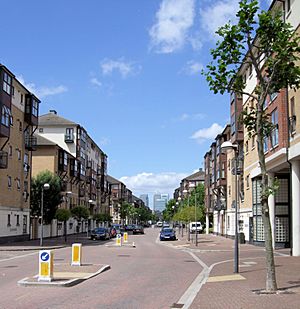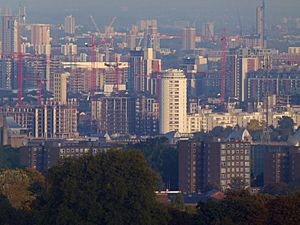Silvertown facts for kids
Quick facts for kids Silvertown |
|
|---|---|
 Wesley Avenue in Britannia Village, a completed part of the Silvertown Quays redevelopment project. |
|
| OS grid reference | TQ415795 |
| London borough | |
| Ceremonial county | Greater London |
| Region | |
| Country | England |
| Sovereign state | United Kingdom |
| Post town | LONDON |
| Postcode district | E16 |
| Dialling code | 020 |
| Police | Metropolitan |
| Fire | London |
| Ambulance | London |
| EU Parliament | London |
| UK Parliament |
|
| London Assembly | |
Silvertown is a neighborhood in East London, England. It is part of the London Borough of Newham. This area sits on the north bank of the River Thames. For a long time, it was part of the county of Essex. Since 1965, Silvertown has been part of Greater London. It shares the E16 postcode area with nearby Canning Town and Custom House.
The name "Silvertown" comes from factories built by Stephen William Silver in 1852. Today, the Tate & Lyle sugar refinery still stands by the river. New homes are being built around it. Silvertown is also home to St Marks Church (now Brick Lane Music Hall), London City Airport, and a new arts center called The Factory Project. A big £3.5 billion plan to rebuild parts of the area was approved in 2015.
Lyn Brown, who was a Member of Parliament for West Ham until May 2024, became Baroness Brown of Silvertown in the House of Lords on January 27, 2025.
Contents
Silvertown's History
Early Factories and Growth
In 1852, S.W. Silver & Company moved to Silvertown from Greenwich. They started a rubber factory there. This factory later became the India Rubber, Gutta Percha and Telegraph Works Company. This company made and laid many underwater cables for communication. By the 1860s, other factories also opened. These included chemical plants and oil storage places. In 1864, Silvertown became its own church parish, with St Mark's Church at its center.
Sugar refiners also came to the area. Henry Tate arrived in 1877, and Abram Lyle in 1881. Their companies joined together in 1921 to form Tate & Lyle. Even though they were rivals, they never actually met. Tate & Lyle still has two large sugar factories in Silvertown today.
Workers' Strike of 1889
In 1889, Silver's factory saw a big strike. Most of its 3,000 workers stopped working for twelve weeks. They wanted better pay. They were inspired by other successful strikes in East London. The factory managers refused to talk with the workers. However, the strikers had a lot of public support. Important leaders in the strike included Tom Mann and Eleanor Marx. In the end, the workers had to go back to work because they ran out of money. Many of them faced problems for their part in the strike. After the strike, Silver's company announced a 5% profit. Other companies praised Silver's for not giving in to the workers' demands.
The Silvertown Explosion
On January 19, 1917, a huge TNT explosion happened at the Brunner-Mond munitions factory in Silvertown. This event is known as the Silvertown explosion. Seventy-three people died, and hundreds were hurt. It was one of the biggest explosions ever in the British Isles.
Transport Challenges and War
In the early 1900s, Silvertown had a lot of traffic. It was located between the River Thames and the Royal Docks. These docks were very busy. The area was often blocked by bridges that lifted for ships. Also, train crossings were closed for up to three-quarters of every hour. To help with this, the Silvertown Way was built in the early 1930s. It was one of the first elevated roads in a city.
During the first night of The Blitz (heavy bombing in World War II), Tate and Lyle's sugar factory was badly damaged. So were John Knight's Primrose Soapworks and the Silvertown Rubber Works.
Silver's factory was later taken over by BTR Industries. It closed in the 1960s. Now, that site is the Thameside Industrial Estate. Another big employer was the Loders and Nucoline plant at Cairn Mills. This factory made fats from palm kernel oil.
Silvertown was part of the old parishes of West Ham and East Ham in Essex. This was true from the 1100s. In 1894, East Ham became an Urban District. West Ham became a county borough in 1900. Then, in 1965, West Ham and East Ham joined to create the new London Borough of Newham.
Modern Silvertown and New Plans
Changes and New Homes
After the old Silvertown train station closed, the local shops and services suffered. Many shops, the post office, a social club, and the library were lost. Of the many pubs that used to be on Albert Road, only one remains. Some new homes were built in the 1980s. But for a long time, not much was done to improve the center of Silvertown.
Further west, a residential area called Britannia Village was built in the 1990s. This area became known as "West Silvertown."
Big Redevelopment Project
On April 21, 2015, Newham Council approved a huge £3.5 billion plan for Silvertown. This project will create 7 million square feet of new buildings. It will include offices, a technology hub, and 3,000 new homes. There will also be special "brand experience pavilions." The plan also includes a school, a health center, and shops. A new bridge will cross the Royal Docks to connect people to Custom House station and Crossrail. However, most of this new development will not directly help the older, historic part of Silvertown.

The Silvertown Partnership is leading this big project. Their goal is to build homes, restaurants, businesses, and public spaces for the community. They believe it will create up to 20,700 new jobs. It could also add £260 million each year to London's economy. The plan also includes fixing up the old Millennium Mills flour factory.
In January 2015, the Mayor of London announced £12 million in government money. This money was to start tearing down parts of Millennium Mills and removing asbestos. Before this latest plan, the area changed a lot in the 1970s. The Thames Barrier was built, along with a park, new homes, and London City Airport. In the mid-1990s, much of the business was centered around the Bass brewing company. In 2007, Prince Richard, Duke of Gloucester visited Silvertown. He officially opened the new Silvertown Ambulance Station on North Woolwich Road.
Education
For more details on schools in Silvertown, see List of schools in the London Borough of Newham.
Maritime Activities
The Tate & Lyle Thames Refinery is a very important port area in London. It is one of the largest sugar refineries in the world. It can process 1.2 million tonnes of sugar each year. The jetties (docks) have two large cranes for moving goods. The refinery handles sugar as dry bulk and edible oils as liquid bulk. It sends products all over the world and brings in sugar from places like Fiji, the Caribbean, Africa, and South America.
Getting Around Silvertown
Train and DLR
The closest Docklands Light Railway (DLR) station is London City Airport. Pontoon Dock station is also nearby. Getting to Silvertown became much easier when the DLR line was extended. This extension from Canning Town to Woolwich Arsenal opened on December 2, 2005.
The old Silvertown railway station on the North London Line closed in 2006. A new London Underground station at nearby Custom House opened in 2022. This station is part of Crossrail. It makes it easier to travel to and from central London, Essex, and even London Heathrow Airport. The new Crossrail line uses the path of the old North London Line. There is a possibility that a new stop for Silvertown could be built in the future.
Other Transport
The London Cable Car connects West Silvertown to the Greenwich Peninsula. London City Airport is located right in central Silvertown. A new bridge will connect West Silvertown with Crossrail's Custom House station. This bridge is part of the £3.5 billion redevelopment plan for London's Royal Docks.
The Silvertown Tunnel is a road tunnel under the Thames. It is expected to open in 2025. It will provide a toll route to the Greenwich peninsula.
Public buses in Silvertown include the 473, which goes from Stratford to North Woolwich. The 474 bus runs from Canning Town to Manor Park. Both the 473 and 474 stop at London City Airport. A new route, the 241, runs between Stratford and Pontoon Dock.
Some efforts have been made to create bicycle lanes. However, ongoing construction and road work limit access. Cyclists often have to share the road with cars.
Famous People from Silvertown
- Frank Bailey (1925–2015), a firefighter.
See Also
- Silvertown explosion
- Silvertown Tunnel



